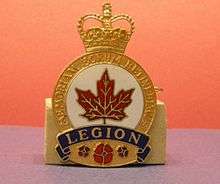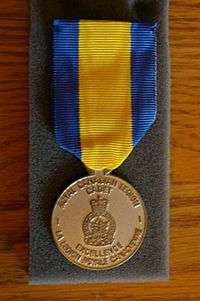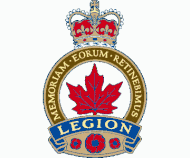Royal Canadian Legion
|
| |
| Abbreviation | RCL |
|---|---|
| Motto |
"Memoriam eorum retinebimus" (Latin) "We Will Remember Them" |
| Formation | November 25, 1925 |
| Type | Ex-service organisation |
| Legal status | Nonprofit Organization |
| Headquarters | Dominion Command |
| Location |
|
Region served | Worldwide |
Membership (2013) | 284,056 |
Grand Patron | David Johnston |
Honourary Grand President | Larry Murray |
Dominion President | Tom Eagles |
| Affiliations | Royal Commonwealth Ex-Services League |
| Slogan | ″There is strength and power in numbers″ |
| Website |
www |
Formerly called | Canadian Legion |


The Royal Canadian Legion is a non-profit Canadian ex-service organization (veterans' organization) founded in 1925.[1] Membership includes people who have served as military, Royal Canadian Mounted Police, provincial and municipal police, Royal Canadian Air, Army and Sea Cadets, direct relatives of members and also affiliated members. Membership is now also open to the general public.
History
In Canada, several veterans' organizations emerged during World War I. The Great War Veterans Association, founded in 1917 by Lillian Bilsky Freiman, was the first national organization for veterans, and by 1919 it was the largest veterans' organization in Canada. Following World War I, 15 different organizations existed to aid returning veterans in Canada. Field Marshal Earl Haig, founder of the British Empire Service League (now known as the Royal Commonwealth Ex-Services League), visited Canada in 1925 and urged the organizations to merge.[2] In the same year, the Dominion Veterans Alliance was created to unite these organizations.[1][2]
In November 1925, the Canadian Legion was founded in Winnipeg, Manitoba, as the Canadian Legion of the British Empire Services League. The Canadian Legion of the British Empire Services League was incorporated by a special act of parliament the following year.[1] The Legion grew steadily through the 1930s and then expanded rapidly following World War II.[2] In 1960, Elizabeth II granted The Legion royal patronage and it became The Royal Canadian Legion.[1]
Recognition
On 10 November 1975 Canada Post issued "The Royal Canadian Legion, 1925–1975" designed by Rudy Kovach. The 8¢ stamps are perforated 13 and were printed by British American Bank Note Company.[3]
National Headquarters
The National Headquarters of The Royal Canadian Legion in Ottawa, Ontario features a Wall of Remembrance.
- The Wall of Remembrance is adorned by an 11-ft long stainless steel sword (2006) by André Gauthier.
- The Royal Canadian Legion commissioned a small work of art on the theme of the Tomb of the Unknown Soldier (2001) by André Gauthier.
- “Of Such as These” (2003) by André Gauthier is a small bas-relief of Canadian World War II fighting men and women presented by the Conference of Defence Associations Institute to The Royal Canadian Legion’s National Secretariat in Ottawa.
Memorials
The Royal Canadian Legion Branch 593 erected a memorial in Ottawa dedicated to those who died in the First and Second World Wars and the Korean War.[4]
Legion museums

A number of military museums are co-located and affiliated with Royal Canadian Legions.
| Name | Town/City/Region | Province | Type | Summary |
|---|---|---|---|---|
| Herman J. Good V.C Branch No.18 Royal Canadian Legion War Museum | Bathurst Gloucester | New Brunswick | Military | information, information |
| Royal Canadian Legion Military Museum | Grand Falls-Windsor | Newfoundland and Labrador | Military | information, information, operated by the Royal Canadian Legion Branch 12 |
| Royal Canadian Legion Military Museum | Dartmouth Halifax Regional Municipality Metro Halifax | Nova Scotia | Military | information |
| Hall of Remembrance Military Museum | Perth Eastern | Ontario | Military | website |
| Royal Canadian Legion Branch 72 Museum | Pembroke Eastern | Ontario | Military | website, information, open by request and for special events, local branch of the Royal Canadian Legion |
| Kensington Veterans Memorial Museum | Kensington Prince | Prince Edward Island | Military | website, adjacent to the Royal Canadian Legion, includes uniforms, medals, hand weapons, flags, photographs and maps |
| Royal Canadian Legion Museum | Saskatoon West Central | Saskatchewan | Military | website, uniforms, medals and memorabilia of the Royal Canadian Legion |
Legion halls
Most small towns and villages in Canada have at least one Legion Hall. Often the Legion Hall is a major community centre, combining the functions of a pub, pool hall, dance hall, bingo hall, banquet hall, and so on.[5]
Legion Halls are numbered, for example "Branch 99 Royal Canadian Legion". This is not a nationwide numbering system as you might expect, however; each provincial Command has its own numerical sequence. "Branch 99", therefore, can refer to any of several Legion Halls, as follows: Belleville, Ontario; Cowansville, Quebec; Lipton/Dysart, Saskatchewan; Coronation, Alberta (a branch that has closed); or Emo, Ontario (in the Manitoba/Northwestern Ontario Command).
The Royal Canadian Legion Maple Leaf Post-84 is located in Royal Oak, Michigan.
Services and activities
Poppy Campaign
The Legion is responsible for Canada's remembrance poppy campaign which distributes plastic lapel poppies to be worn in the lead up to Remembrance Day. The poppy is worn on the left lapel, or as close to the heart as possible.[6] The current lapel poppy has been manufactured since 1922—originally under the sponsorship of the Department of Soldiers Civil Re-establishment.[6] Until 1996, the poppy material was manufactured at sheltered workshops operated by Veterans Affairs Canada.[6] Poppies are distributed through retail outlets, workplaces, Legion branches, malls and other locations across Canada. Typically, the poppies are offered up for donation as a symbol of Remembrance,using an honour system, with the poppies being left in open places with a receptacle for leaving a donation toward the campaign. Funds raised are used to support ex-service members in need [6] and to fund medical appliances and research, home services, care facilities and numerous other purposes benefiting veterans.[7]
Memorial activities
Members of the Legion perform graveside memorial ceremonies for veterans at cemeteries throughout Canada. The Legion also performs ceremonies annually at the gravesites of Canadian and British servicemen interred in the United States, generally on a Sunday in May.
Legion Athletic Camp
In 1962 the Legion began a summer sports camp at the International Peace Garden which is run to this day, and has helped to train over 48,000 school age athletes. Several sports are offered over a five-week period. The program was founded by George Phillips and Fred Taylor (see www.legionathleticcamp..com).
Lest We Forget Project
The Legion supports the Lest We Forget Project in cooperation with the Canadian War Museum.
Legion Military Skills Conversion Program
In 2015, the Royal Canadian Legion, donated $830,000 to the BCIT School of Business to fund the Legion Military Skills Conversion Program. This program helps Canadian veterans and reservists convert their military skills and knowledge into a business credential.[8] (see www.bcit.ca/legion)
Membership
Membership in The Royal Canadian Legion was originally restricted to ex-service members of Canada's Armed Forces and Merchant Navy.[9] The organization is now open to members of the general public. There are four categories of membership.[10]
Ordinary membership
Ordinary membership is open to anyone who has served or is serving in one of the following:
- The Canadian Forces or Her Majesty's Forces (including regular force or reserve force under class "C" service).
- Forces or underground forces of any of Her Majesty's allies in any war, conflict or police action in which Canada was involved.
- The Merchant Navy or non-military services in an actual theatre of war in which Canada was involved.
- Her Majesty's reserve forces including Cadet Instructors on the Cadet Cadre for not less than one year.
- The Royal Canadian Air, Army or Sea cadets for no less than 3 years of the joined date.
- The Royal Canadian Mounted Police or The Royal Newfoundland Constabulary for not less than one year.
- The forces of a country while that country was a member of NATO or NORAD in alliance with Canada.
- The forces of the United States.
- The Vietnam War with the Armed Forces of the United States, Australia, New Zealand, the Republic of Korea or South Vietnam, and were a Canadian citizen or Commonwealth subject at the time of service.
- The Canadian Coast Guard as an officer or crew member who has two or more years active service on the high seas or inland waterways.
- A city, municipal or provincial police force as a police officer for not less than one year.
Associate membership
Individuals who do not qualify for ordinary membership can be associate members if one of the following applies:
- They are the child, stepchild, adopted child, grandchild, sibling, niece/nephew, widow/er, parent or spouse of someone who is or was eligible for ordinary membership.
- They are the child of an associate member.
- They have served as a cadet civilian instructor for not less than 3 years.
- They have served as an officer in the Navy League of Canada for not less than 2 years.
- They have served in the Polish Armed Forces after World War II below the rank of officer.
- They have served in a City, Municipal, Volunteer, Un-organized Territories or Federal Fire Service for not less than one year.
- They are the spouse, parent or sibling of an associate member who qualified subject to the above criteria.
Affiliate voting membership
Commonwealth subjects who do not qualify for ordinary or associate membership are eligible for affiliate membership.
Affiliate non-voting membership
Non-Commonwealth subjects from an Allied nation who support the aims and objects of The Royal Canadian Legion can apply for affiliate non-voting membership.
See also
References
- 1 2 3 4 "history". Royal Canadian Legion. Royal Canadian Legion. Retrieved 8 April 2012.
- 1 2 3 "Royal Canadian Legion". Canadian Encyclopedia. Canadian Encyclopedia. Retrieved 8 April 2012.
- ↑ Canada Post stamp
- ↑ Royal Canadian Legion Branch 593 memorial
- ↑ "Royal Canadian Legion hall: Canadian Geographic Magazine".
- 1 2 3 4 "The Poppy Campaign". Royal Canadian Legion. Royal Canadian Legion. Retrieved 8 April 2012.
- ↑ "The Poppy". Veterans Affairs Canada. Government of Canada. Retrieved 8 April 2012.
- ↑ "Legion Military Skills Conversion Program". Fuller-Evans, Janaya. Burnaby Now. Retrieved 25 August 2016.
- ↑ "Membership Services". Royal Canadian Legion. Royal Canadian Legion. Retrieved 4 April 2012.
- ↑ "Who Can Join?". Royal Canadian Legion. Royal Canadian Legion. Retrieved 4 April 2012.
External links
| Wikimedia Commons has media related to Royal Canadian Legion. |
| Wikinews has related news: |
- List of Civilian organizations with prefix "Royal" - Heritage Canada.
- List of civilian organizations with the prefix "Royal" prepared by the Department of Canadian Heritage
- Commonwealth War Graves Commission - official Website
- Returned & Services League of Australia
- Legion Athletic Camp
The 5P Legal Services Team provides assistance for veterans completing and submitting application forms and effective representation for veterans appearing at Veterans Review and Appeal Board hearings in Ottawa and Ontario.
